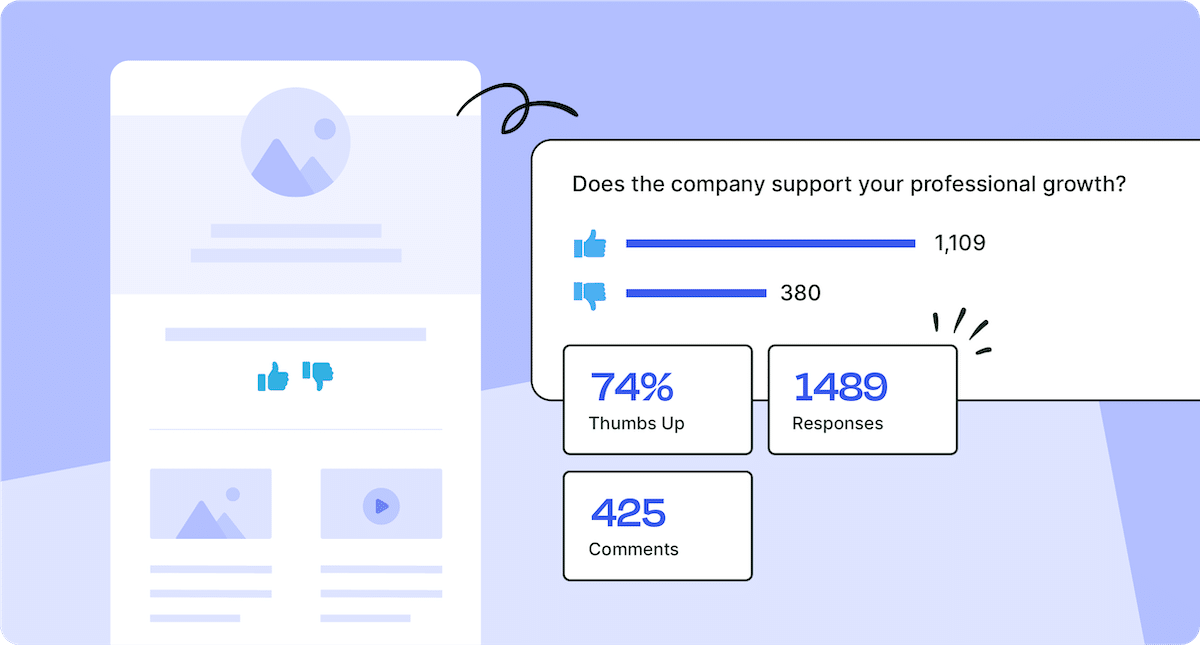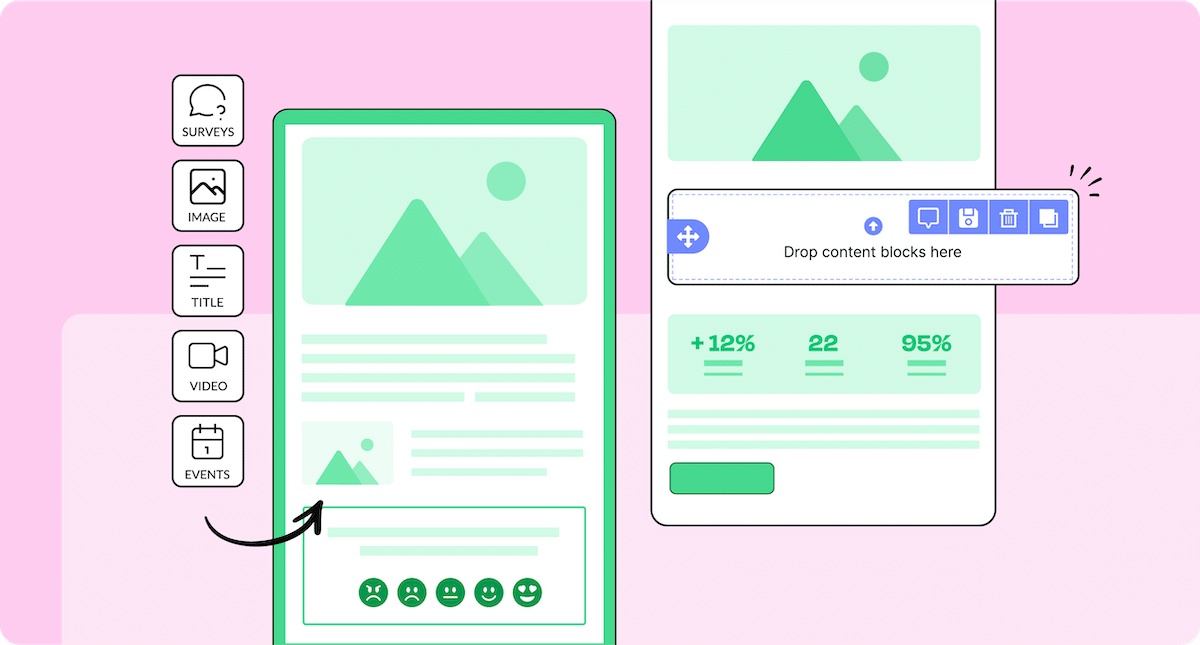What is an internal audience and why, as a communicator, should you care? Read along as we break down how to use internal target audiences to create stickier, more engaging comms across your organization.
Imagine trying to plan a surprise birthday party without knowing anything about the person—what they like, who their friends are, or even when their birthday is. Sounds like a recipe for disaster, right? Now think about sending internal communications without tailoring them to your internal audience.
If you’re sending out blanket communications without understanding the various internal audiences and their motivations, you’re basically throwing a party that no one wants to attend.
This is where understanding your internal target audience becomes a superpower.
Whether you’re in HR or internal comms, learning how to manage and engage your internal vs. external audience will make a massive difference. Read along as we explore how to turn your employee communications into something that feels directly targeted to your internal audience.
Revive employee engagement with targeted, interactive emails and newsletters
Book a 15 minute call with one of our team members
What Is an Internal Audience?
An internal audience refers to the individuals within your organization who receive and engage with your internal communications. This includes employees, management teams, leadership, and even contractors or part-time staff.
Now, let’s talk about the key difference between an internal vs external audience. Your internal audience is made up of people already within your business ecosystem. In contrast, an external audience includes customers, media, investors, or the general public. That distinction is important when you’re planning messaging, choosing platforms, and setting goals.
Benefits of Engaging and Managing Internal Audiences
Why should you invest time and effort into identifying, managing, and segmenting your internal audiences?
Here are the key benefits of internal audience segmentation:
- Stronger engagement: Tailored communication increases relevance, which boosts open rates and employee action.
- Higher productivity: Clear, timely information helps employees focus and collaborate better.
- Improved morale: Personalized communication makes people feel seen and valued.
- Better alignment with business goals: Segmenting by department, location, or role ensures everyone hears what matters to them.
- Smarter decision-making: Audience segmentation data can reveal gaps, pain points, and opportunities for specific employee groups.
10 Ways to Manage and Engage Your Internal Audiences
Whether you’re trying to increase employee engagement or align teams with business goals, understanding your internal audience is the first step—and it only gets better from there. Here’s how to take your comms from generic to laser-focused.
1. Start with internal audience segmentation
Not all employees need to hear the same message in the same way. Internal audience segmentation groups employees together based on relevant traits—like department, role, or location. This way, messages are more targeted and engaging to the primary internal audience.
Why this matters: Segmentation is the backbone of effective internal communications. It ensures that your messaging strategy aligns with employee expectations, drives meaningful engagement, and supports broader business objectives. It’s also essential for managing the internal audience vs external audience conversation since internal messaging needs to be far more targeted and personal.
Actionable tips:
- Use your HR system to break audiences into clear internal audience segments.
- Start simple: segment by department or location.
- Build out complexity over time as you learn what works.
Practical examples:
- Only send IT maintenance alerts to affected departments.
- Target DEI initiatives to underrepresented employee groups.
- Localize employee surveys by region.
What to avoid:
- Sending “all staff” internal audience emails too frequently.
- Not sending clear and precise messaging to internal audiences that is differentiated from generalized emails
PRO TIP: ContactMonkey allows you to segment your internal email list using real-time employee data, ensuring that your messages are relevant and personalized. ContactMonkey’s list segmentation and Dynamic Content feature lets you send unique content to your internal audiences, all in a single campaign. Still not convinced? Here are more reasons why use internal email lists.
2. Perform internal audience mapping to define personas
Once you’ve segmented your internal audience, take it a step further by creating personas. These help you understand all internal audience characteristics to pinpoint what motivates each group and how they consume content. This way, you can tailor your messaging to resonate while being scalable.
Why this matters: Personas give life to your segments and ensure you’re not just targeting roles—you’re connecting with real people. When communicators understand internal communication goals, challenges, and communication preferences of different personas, internal messaging becomes more empathetic and strategic.
Actionable tips:
- Interview or survey employees from each segment to set your various internal audience examples.
- Create simple personas with traits, behaviors, and preferred channels for each internal target audience.
- Include internal target audience pain points and content needs to shape future messages.
Practical examples:
- “New Hire Noah” might want onboarding checklists and company culture explainers.
- “Remote Rachel” may prefer shorter Slack updates in real-time instead of email.
- “Manager Marcus” wants formal, in-depth strategic info he can cascade to his team.
What to avoid:
- Not defining internal audience characteristics and assuming everyone in a department behaves the same.
- Overcomplicating internal audience examples with unnecessary details.
PRO TIP: Use ContactMonkey’s pulse surveys feature to help you collect feedback and behavioral insights to validate personas. Use the data to refine your approach and create internal audience segments based on individual preferences versus obvious differentiators like role or department.
3. Personalize your email communications as much as possible
People pay more attention to content that feels like it was written for them. Personalized communications help each internal corporate audience feel valued and acknowledged. After all, no one wants to be referred to in an email as, “Dear Employee.”
Why this matters: Internal communications personalization increases engagement, drives action, and builds trust with your employees. It’s especially critical when managing multiple segments in your internal email list. Tailoring content also shows that you understand your audience’s specific needs—something that clearly differentiates a strong internal audience strategy from an external audience approach.
Actionable tips:
- Use first names and roles in subject lines or headers.
- Mention team milestones or regional office news.
- Customize content length and format based on the audience’s preference.
Practical examples:
- “Hi Alex, here’s your department’s Q2 goals.”
- Share success stories or updates tied to specific teams.
- Address FAQs differently for frontline workers and corporate staff.
What to avoid:
- Sending generic “all-staff” emails that feel cold or irrelevant.
- Overusing personalization in a way that feels creepy or robotic.
PRO TIP: With ContactMonkey, you can personalize emails at scale using merge tags and smart fields—turning your employee email list management into a powerful engagement tool. You can even leverage our Multi-Language email feature. Plus, if you’re looking for more, check out our article on how to send personalized emails.
Organize your contacts with list management
Save time managing employee lists by syncing everything in one place.
4. Use smart internal email distribution lists
Keeping your internal email distribution list accurate and aligned with your audience segments is key to delivering relevant content. If you’re still managing lists manually, it’s time to upgrade.
Why this matters: A smart, dynamic internal email list helps you avoid miscommunication and reach the right people every time. It’s also essential for internal email list management as your company scales or experiences turnover. Clean distribution lists help you better execute your internal audience strategy while avoiding overloading inboxes.
Actionable tips:
- Sync lists with your HRIS or Active Directory for real-time updates.
- Use dynamic fields like department, location, or seniority for auto-populated lists.
Conduct quarterly audits to remove inactive or incorrect addresses.
Practical examples:
- Send facility updates only to employees based in the head office.
- Automatically add new hires to the onboarding list.
- Exclude senior leadership from daily operational emails.
What to avoid:
- Relying on IT every time you need to update a list.
- Sending the same email to 100% of your company when it’s only relevant to 25%.
PRO TIP: ContactMonkey allows you to build and manage smart, segmented internal email distribution lists directly from the Outlook or Gmail integration feature, so your communications are always targeted and up to date—without IT help.
Integrate your tools with ContactMonkey
Bring your favorite platforms together and save hours of work.
5. Align internal comms with internal audience motivation
Each internal audience has unique objectives, challenges, and priorities. When you align your messaging with what matters to them, your communications feel intentional—not transactional.
Why this matters: Employees are far more likely to engage with communications that help them succeed in their roles. Aligning messages with their goals, and educational or extra training offerings, signals to employees that you care about their career growth.
Actionable tips:
- Understand each segment’s KPIs, pain points, and preferred content types.
- Connect updates directly to how they impact the team.
- Frame content in a way that shows value for that specific group.
Practical examples:
- Explain how a policy update supports frontline efficiency.
- Show sales teams how a new tool helps hit their targets faster.
- Share department-specific dashboards to visualize team impact.
What to avoid:
- Copy-pasting the same message to all groups.
- Sharing company updates without explaining their impact on employees.
6. Keep communications channel-specific for internal target audiences
Email isn’t the only way to reach employees—and it shouldn’t be. Different internal audience segments engage on different platforms, so your messaging should meet them where they already are.
Why this matters: Channel-specific communication improves accessibility and ensures employees actually see your message. For example, office-based employees may rely on Outlook, while frontline teams might prefer mobile alerts or Slack. Understanding these differences helps you deliver messages more effectively, which is especially important when managing your internal and external target audience strategies.
Actionable tips:
- Survey teams on their preferred communication channels.
- Create an internal communication channel matrix to guide your efforts.
- Use email for detailed updates, chat tools for quick nudges, and video for storytelling.
Practical examples:
- Use Slack to share quick reminders about events or surveys.
- Send mobile-optimized emails to remote and field employees.
- Publish detailed strategic updates via internal newsletters.
What to avoid:
- Spamming the same message on every platform.
- Using a channel just because it’s trendy—focus on where your people are.
PRO TIP: With ContactMonkey’s responsive email templates available through the email builder feature, you can ensure your messages are mobile-friendly, readable, and formatted perfectly—no matter how or where your internal audience opens them. In addition, you can push email, SMS, and intranet updates through ContactMonkey and the SharePoint integration.
7. Collect feedback and adapt communications
Want to know if your messages are hitting the mark? Ask! Feedback from your internal audience is one of the most valuable tools you have for shaping better communication strategies.
Why this matters: Feedback transforms your internal communications from a one-way push to two-way communication. Real-time feedback gives insights into how your internal audience is responding to content. Internal audience segmentation data plus feedback can deliver powerful insights about specific pockets of your employees.
Actionable tips:
- Include pulse surveys or emoji reactions in your emails.
- Ask targeted questions based on internal audience segments (e.g., team-specific concerns).
- Follow-up on feedback with visible actions or updates.
Practical examples:
- “Did this update help clarify the new policy?” 👍👎
- Use open-text fields to capture ideas for future communications.
- Create a monthly “You said, we did” summary to show impact.
What to avoid:
- Ignoring feedback or failing to close the loop.
- Asking for feedback too often without a clear purpose.
Pulse surveys that actually engage employees
Get instant feedback with our interactive survey tools—without switching platforms.
8. Use internal target audiences to deepen engagement analyses
If you’re not tracking engagement, you’re guessing. And with multiple internal audiences to manage, guessing can lead to missed opportunities, low morale, or message fatigue.
Why this matters: Analyzing email metrics—like open rates, click-throughs, and read times—helps you understand how each internal audience interacts with your content. It also enables better decision-making around content types, timing, and formats. This data-driven approach strengthens your overall internal comms strategy and makes internal communications audience analysis actionable.
Actionable tips:
- Review performance by department, location, or role.
- Test different subject lines and layouts to optimize content.
- Compare engagement trends over time to spot opportunities.
Practical examples:
- Notice that your Operations team prefers short-form content? Adjust accordingly.
- Are employees ignoring IT’s compliance reminders? Try a new subject line or format.
- Track engagement with leadership messages vs. team-specific updates.
What to avoid:
- Focusing only on company-wide stats.
- Measuring vanity metrics without context.
PRO TIP: ContactMonkey’s email analytics dashboard breaks down engagement by segment, so you can understand exactly how each internal audience responds to content—and adjust your approach accordingly.
9. Recognize employee contributions by writing for internal audiences
Recognition isn’t just a “feel good” add-on—it’s a key part of internal engagement. Shouting out wins in your internal comms keeps morale high and shows your internal audience that their work matters.
Why this matters: Celebrating success helps people feel seen, appreciated, and connected. When recognition is timely, authentic, and tailored to the audience, it reinforces culture and motivates performance. It also humanizes your communications, creating an emotional resonance that’s difficult when you compare internal vs. external audiences.
Actionable tips:
- Include shoutouts in newsletters, Slack channels, or leadership messages.
- Encourage peer-to-peer recognition through open submissions.
- Consider fun and creative ways to celebrate employees through these employee recognition ideas.
Practical examples:
- “Big thanks to the Customer Support team for resolving 500 tickets last week!”
- Feature a monthly spotlight on employee contributions by region.
- Recognize teams behind the scenes—not just high-visibility roles.
What to avoid:
- Making praise generic or repetitive.
- Only highlighting senior leadership achievements.
10. Tailor content for global teams with internal audience mapping
When communicating across multiple regions, cultures, and time zones, one-size-fits-all messaging is not effective. Each internal audience deserves content that feels local and relevant.
Why this matters: Localization goes beyond translating content—it’s about ensuring your message fits the cultural, linguistic, and logistical context of each region. Global employees often feel disconnected from HQ communications, so tailored messaging boosts relevance, respect, and inclusivity. It’s a key part of balancing your internal and external target audience strategies.
Actionable tips:
- Use regional email templates with localized images, tone, and examples.
- Schedule sends based on time zone.
- Account for local holidays or events in your content calendar.
Practical examples:
- Include region-specific office updates or leadership messages.
- Send French-language emails to your Montreal team
- Highlight culture-specific employee celebrations in local newsletters.
What to avoid:
- Translating word-for-word without adapting tone or references.
- Sending HQ-focused content to global teams without context.
Leveraging Technology and Tools for Internal Audience Engagement
Still trying to manage your employee email list in spreadsheets or outdated systems? Yikes. Modern internal comms need modern tools. Internal email platforms will help you to:
- Segment and manage your internal email distribution list without needing IT.
- Automate internal email list management based on HRIS data.
- Analyze which content works for which internal audience—and why.
With the assistance of technology, you can send the right emails to the right people at the right time.
Internal Audience Analysis and Measurement with ContactMonkey
To enhance your internal communications, it’s not just about sending tailored content; it’s crucial to measure its impact. With ContactMonkey, you gain valuable insights into how your internal audience is engaging, allowing you to continuously refine your strategy and improve outcomes. Here’s how ContactMonkey empowers you to analyze and measure your internal audience’s engagement effectively:
- Audience segmentation for targeted insights: Segment your email list by department, role, or location to understand how different groups engage with your content. This allows for more personalized and effective communication.
- Track key engagement metrics: Monitor open rates, click-through rates, and other metrics by segment to identify what resonates with each audience and where adjustments are needed.
- Spot content trends and preferences: Analyze which topics and formats drive the most engagement. This will help you understand your audience’s interests and adapt your content accordingly.
Real-time analytics for quick adjustments: Make immediate changes to your messaging, frequency, or design based on real-time data, optimizing your internal communications for better engagement. - Embed surveys for direct feedback: Embed surveys and pulse checks in your emails to gather real-time feedback and make data-driven decisions to continuously improve your strategy.
Want more tips on audience segmentation and email engagement? Book a free demo to discuss your organization’s unique challenges!


